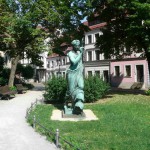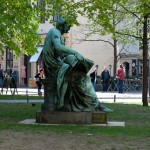Monuments and Sculptures
Monuments and sculptures of Nicholas Quarter
Clio – the Muse of History
Sculptor Albert Wolff (1814 – 1897)
Location: in front of St. Nicholas Church

Clio is a base figure of the equestrian statue of Frederick William III., which was once found in the Lustgarten. The equestrian statue originally consisted of six figures, was unveiled in 1871 and the figures were finally placed in 1876. In the 2nd World War the monument was melted down. Only two figures remained relatively undamaged. One is Klio “The Muse of History” and the other “science” – both are now located behind the St. Nicholas Church.
The left hand of the base figure was once touching the monument base, while the right hand wrote.
The allegory of science
Sculptor Albert Wolff (1814 – 1897)
Location: behind the Church of St. Nicholas
 The “Allegory of science” just like “Clio – The Muse of History”, is a base figure of the equestrian statue of Frederick William III. The equestrian statue was originally made of six figures base, was unveiled in 1871 and the figures were finally placed 1876. During the 2nd World War II the monument was melted down. Only two figures remained relatively undamaged. One is the “Allegory of Science” and the other “Clio – the Muse of History” – located in front of St. Nicholas Church. The two 3m high bronze figures were moved to the Nikolai Quarter in 1987. The “Allegory of science” represents a thoughtful man who braces reading a great book with the right hand against his thigh. With his left hand he holds a globe on the other leg. Another figure which was part of the original ensemble, “Genius of Science”, is now at the Heinrich-von-Kleist Park in Schöneberg.
The “Allegory of science” just like “Clio – The Muse of History”, is a base figure of the equestrian statue of Frederick William III. The equestrian statue was originally made of six figures base, was unveiled in 1871 and the figures were finally placed 1876. During the 2nd World War II the monument was melted down. Only two figures remained relatively undamaged. One is the “Allegory of Science” and the other “Clio – the Muse of History” – located in front of St. Nicholas Church. The two 3m high bronze figures were moved to the Nikolai Quarter in 1987. The “Allegory of science” represents a thoughtful man who braces reading a great book with the right hand against his thigh. With his left hand he holds a globe on the other leg. Another figure which was part of the original ensemble, “Genius of Science”, is now at the Heinrich-von-Kleist Park in Schöneberg.
St. George – The Dragon Slayer
 Saint George, who kills the dragon on horseback and, according to legend, not only freed the princess from the monster, but an entire city, is one of the most photographed monuments in Berlin. The 6m high statue group by sculptor August Kiss (1802 – 1865) is fascinating for its detailed design. Until the demolition of the Stadtschloss, the monument was located in it’s courtyard, later in Friedrichshain park. With the reconstruction of the Nikolaiviertel the equestrian statue has found a proper place in Berlin’s historic center. Right by the Spree River and facing the oldest church in the city – St. Nicholas Church. From March 2010 to June 2011, the figure and the base have been painstakingly restored. The total cost was € 120,000. The equestrian statue is placed somewhere between late Classicism and Neo-Baroque. August Kiss was born in 1802 in Silesia and died in 1865 in Berlin. Kiss has created more famous works, for example the equestrian statue of Frederick the Great in Breslau or the statue of Frederick William in Potsdam. All christian churches remember Saint George on 23rd April. St. George was a martyr of the early fourth century, in the time of persecution of Christians under the Roman Emperor Diocletian. Over the centuries, legends formed around him. The most important of these is preserved in the “Legend aurea”, a collection of stories of the 12th St. Century.
Saint George, who kills the dragon on horseback and, according to legend, not only freed the princess from the monster, but an entire city, is one of the most photographed monuments in Berlin. The 6m high statue group by sculptor August Kiss (1802 – 1865) is fascinating for its detailed design. Until the demolition of the Stadtschloss, the monument was located in it’s courtyard, later in Friedrichshain park. With the reconstruction of the Nikolaiviertel the equestrian statue has found a proper place in Berlin’s historic center. Right by the Spree River and facing the oldest church in the city – St. Nicholas Church. From March 2010 to June 2011, the figure and the base have been painstakingly restored. The total cost was € 120,000. The equestrian statue is placed somewhere between late Classicism and Neo-Baroque. August Kiss was born in 1802 in Silesia and died in 1865 in Berlin. Kiss has created more famous works, for example the equestrian statue of Frederick the Great in Breslau or the statue of Frederick William in Potsdam. All christian churches remember Saint George on 23rd April. St. George was a martyr of the early fourth century, in the time of persecution of Christians under the Roman Emperor Diocletian. Over the centuries, legends formed around him. The most important of these is preserved in the “Legend aurea”, a collection of stories of the 12th St. Century.
Heinrich Zille
Sculptor: Thorsten Stegmann (1969)
Location: Poststraße
The half-ton limestone sculpture is a tribute to painter and Berlin original Heinrich Zille (1858 – 1929). “Surprisingly emaciated” is inscribed on the plaque nearby – because Zille enjoyed lush corpulence. But that was the suggestion of the artist, the presentation of one of the most prominent Berliners merging with his characters. The people with whom Zille lived and whom he has drawn. Nearby, a few steps toward the river Spree, is the Zille Museum. There, visitors can learn more about the life and work of the 80th honorary citizen of Berlin. There is even a Zille store, with literature, postcards and more to buy. Located at Nikolaikirchplatz, be sure to visit the “Theater im Nikolaiviertel” – where you can hear the famous “Berlin snout” in an impressive theatrical performance to “Zille’s Milljöh” – Zille’s neighborhood.
Read more
From the legend aurea
George the Knight was born of the Cappadocian lineage; he once came to the land of Lybia, to the city of Silena. Near the city there was a lake as big as a sea, in which lived a poisonous dragon, who had often driven the whole people into flight when they were armed against him. Then he came right under the walls of the city and polluted everything with his poisonous breath. So the citizens gave him two sheep a day to quench his fury; otherwise he came under the walls of the city and polluted the air with his poisonous breath, so that many died. But when the sheep were few, and there were never enough of them, it was agreed that one man and one sheep should be sacrificed to the worm every day. So they cast lots to see which man or woman they should give to the dragon, and no one could escape. When almost all the sons and daughters of the city had been sacrificed, it happened that the king’s daughter was chosen by lot to be given to the dragon. Then the king was saddened and said, “Take my gold and silver and half of my kingdom, but leave me my daughter, lest she die so miserably. This angered the people, and they said, “King, you gave the commandment yourself: we had to lose all our children, and you want to keep your daughter? If you do not fulfill in her the law you gave, we will burn you and your house. When the king saw her earnestness, he began to lament his daughter, saying, “Alas, my child, what shall I do with thee, what shall I speak? Ah, never shall I see thy marriage”. And to the people he said, “I pray you, let me have but eight days more, that I may lament for her.” This they granted him. But on the eighth day the people came in crowds and cried out in anger, “Why are you spoiling your land for the sake of your daughter? For we must all die from the dragon’s breath”. Then the king, seeing that he could not save his daughter, had her clothed in royal garments, embraced her, and said to her with tears, “Oh, dear daughter, I thought to raise royal children from your womb; now you are being devoured by the dragon. I thought to invite noble princes to thy wedding, to adorn the castle with pearls, to hear timbrels and trumpets; now thou goest that the dragon may eat thee.” And kissing her, he cried, “O daughter; I had better die before thee, than that I should lose thee thus.” Then she fell down at her father’s feet and asked for his blessing. He gave it to her with tears, and she set out for the lake. Then St. George came riding along, and seeing her weeping, asked what was the matter with her. She answered, “Good youth, get on your horse quickly and flee, or you will perish with me. George said, “Do not be afraid, dear daughter, but tell me what you are waiting for here in the sight of all the people.” She answered “Lord, I see that you are noble in heart, but do you desire to die with me? Flee from here in haste”. George said, “I will not come from this place until you tell me what is yours. Then she told him everything.
But he said, “Dear daughter, be without fear, I will help you in the name of Christ. She said, “Good knight, you will not die with me; it is enough for me to perish, for you will not save me, but you will perish with me. While they were still speaking, behold, the dragon lifted his head out of the lake. The maiden trembled with terror and cried, “Flee, good lord, flee as fast as thou mayest.” But George jumped on his horse, made the cross in front of him and rode against the dragon, who came against him; he swung the lance with great power, commanded himself to God, and hit the dragon so hard that he fell to the ground. Then he said to the virgin “Take your belt and throw it around the worm’s neck, and fear nothing”. She did so, and the dragon followed her like a tame little dog. When she led him into the city, the people were frightened and fled to the mountains and into the caves, saying “Woe is us, now we are all lost. Then St. George beckoned to them and called out, “Fear not, for the Lord God has sent me to you to deliver you from this dragon. Therefore believe in Christ and receive baptism all of you, and I will slay this dragon”. Then the king was baptized and all the people with him, and Saint George drew his sword and slew the dragon. Then he ordered him to be taken out of the city, and four pairs of oxen dragged him out of the city into a large field. On that day 20,000 people were baptized, not counting the women and children.



